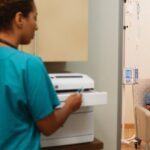Safeguarding patient safety and reducing misconnection errors
“Wrong route” medication errors can have catastrophic consequences, including paraparesis, paraplegia or death.1,2 These types of errors typically occur as the result of misconnections, where medication is administered using the wrong route, such as administering an epidural medication by an intravenous line, administering an intravenous medication by an epidural line, or delivering medication intended for intravenous administration intrathecally instead.1,3,4,5
The role of Luer connectors in “wrong route” errors
The standardised Luer connection systems in use today were designed to provide highly reliable leak-free connections between tubes, syringes and other accessories.3,4,5 They feature a universal male-female configuration that can be used across different types of medical equipment.3 That universal use, however, has been identified as a root cause of wrong route medication errors.4,6,7
More on this topic: Make the safety switch: 4 potential everyday safety hazards
Neuraxial misconnection errors
The simple and functional design of Luer connectors contributes to their ease of use.3,5,8 However, these design features also allow for misconnections between medication delivery routes.3,5,8
A review of 20 years’ worth of case reports representing 133 case studies covering 1999 to 2019 showed that the most commonly reported event involved administering an epidural medication by an intravenous line (29.2% of events); 27.7% of events involved administering an intravenous medication by an epidural line; and 25.4% of events resulted from medication intended for intravenous administration, but which was delivered intrathecally.1
How widespread are the impacts? These are some examples:
- In one survey of obstetric anaesthetist units in the U.K., 20% of units reported accidental connection of local anaesthetic solutions to intravenous (IV) systems and 7% reported epidural administration of medications intended for IV administration.9
- Over 2 years (2006–2008), 6.6% (n=40) of all reported critical paediatric anaesthesia incidents in the U.K. were categorised as wrong drug, wrong route of administration or wrong dose for critical paediatric anaesthesia.10
NHS replaces Luer connectors with a safer option
In recognition of these risks to patient and medication safety, the National Health Service (NHS) England National Patient Safety Team has issued a national patient safety alert instructing all relevant NHS funded providers to transition to NRFit™ connectors for all intrathecal and epidural procedures, and delivery of regional blocks, to be completed by January 31, 2025.11
NRFit™ is the name of the neuraxial connectors that were developed to align with the ISO 80369-6 directive, part of the 80369 series of standards for small bore connectors issued in 2016.7,12 They’re about 20% smaller than a Luer connector, and in addition to the change in size, they also feature other design elements to prevent misconnections, such a collar on the slip male connections.7,13 The changes illustrate the “forced-function” design concept, which is central in preventing medication errors – because of the way the product is designed, it’s almost impossible to make a connection mistake.14
Trend to use yellow colour-coding for neuraxial connectors: In addition to the design changes of the NRFit™ connectors, there is also a trend in parts of the world to use the colour yellow to indicate neuraxial routes.3,7
More on this topic: What can we learn from the new regional anaesthesia survey?
Putting the standards and NRFit™ into action:
The UK is leading the way as one of the first European countries to issue a national patient safety alert instructing all relevant NHS funded providers to transition to NRFit™ connectors.11 Around the globe, adoption rates vary, but most countries and regions are working on creating plans to implement the standards for connectors.3,7
References
- Viscusi ER, Hugo V, Hoerauf K, F Southwick. Neuraxial and peripheral misconnection events leading to wrong-route medication errors: a comprehensive literature review. Reg Anesth Pain Med, 2021. doi:10.1136/rapm-2020-101836.
- Koczmara C, Hyland S, Cheng R. Epidural medications given intravenously may result in death. Dynamics. 2007;18(3):34-36.
- Litman RS, Smith VI, Mainland P. New solutions to reduce wrong route medication errors. Pediatr. Anesth. 2018;28(1):8-12.
- Block M, Horn RJ, Schlesinger MD. Reducing risk of epidural intravenous misconnections. APSF Newsletter. 2012;26(3):63-66.
- Cook TM. Non-Luer connectors: are we nearly there yet? Anaesthesia. 2012;67(7):784-792.
- Joint Commission. Managing risk during transition to new ISO tubing connector standards. Sentinel Event Alert. 2014;53.
- GEDSA. GEDSA Guidance on the Introduction of NRFit®. Frequently Asked Questions Neuraxial Connectors (ISO 80369-6). Published October 19, 2016 (v2). Accessed May 15, 2024. Available at: https://stayconnected.org/faqs-neuraxial-connectors-iso-80369-6/
- International Organisation for Standardisation (ISO). Part 6: Connectors for neuraxial applications. In: ISO 80369-6:2016 Small Bore Connectors for Liquids and Gases in Healthcare Applications. ; 2016. Accessed June 26, 2024. https://www.iso.org/obp/ui/#iso:std:iso:80369:-6:ed-1:v2:en
- Jones R, Swales HA, Lyons GR. A national survey of safe practice with epidural analgesia in obstetric units. Anaesthesia. 2008;63(5):516-519.
- MacLennan AI, Smith AF. An analysis of critical incidents relevantto pediatric anesthesia reported to the UK National Reporting andLearning System, 2006-2008. Pediatr. Anesth. 2011;21(8):841-847.
- NHS England. National Patient Safety Alert – Transition to NRFit™ connectors for intrathecal and epidural procedures, and delivery of regional blocks. Published January 2024. Accessed May 15, 2024. https://www.england.nhs.uk/wp-content/uploads/2024/01/NRFit-NatPSA-Final-v1.pdf
- Brown J. The life and death of the luer. 2012. Available at: https://www.mddionline.com/life-and-death-luer. Accessed: August 29, 2019.
- Cook TM, Wilkes A, Bickford Smith P, et al. Multicentre clinical simulation evaluation of the ISO 80369-6 neuraxial non-Luer connector. Anaesthesia. 2019;74(5):619-629.
- Institute For Safe Medication Practices (ISMP). NRFit: A global “fit” for neuraxial medication safety. Published July 6, 2020. Accessed May 15, 2024. Available at: https://www.ismp.org/resources/nrfit-global-fit-neuraxial-medication-safety
This list of references to third-party peer-reviewed material and the sites they are hosted on are provided for your reference and convenience only, and do not imply any review or endorsement of the material or any association with their operators. The Third-Party References (and the Web sites to which they link) may contain information that is inaccurate, incomplete, or outdated. Your access and use of the Third Party Sites (and any Web sites to which they link) is solely at your own risk.
NRFit™ is a trademark of GEDSA. Used with permission.




